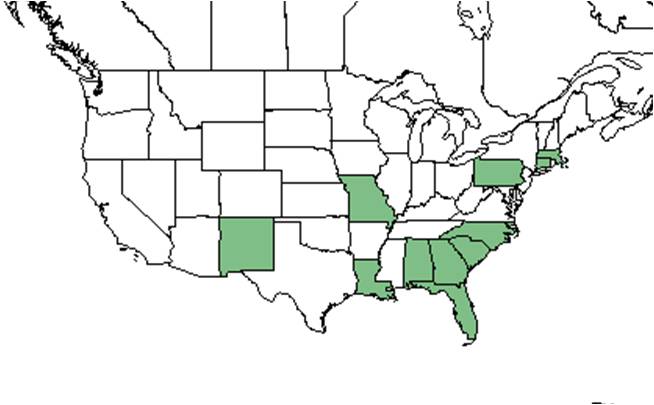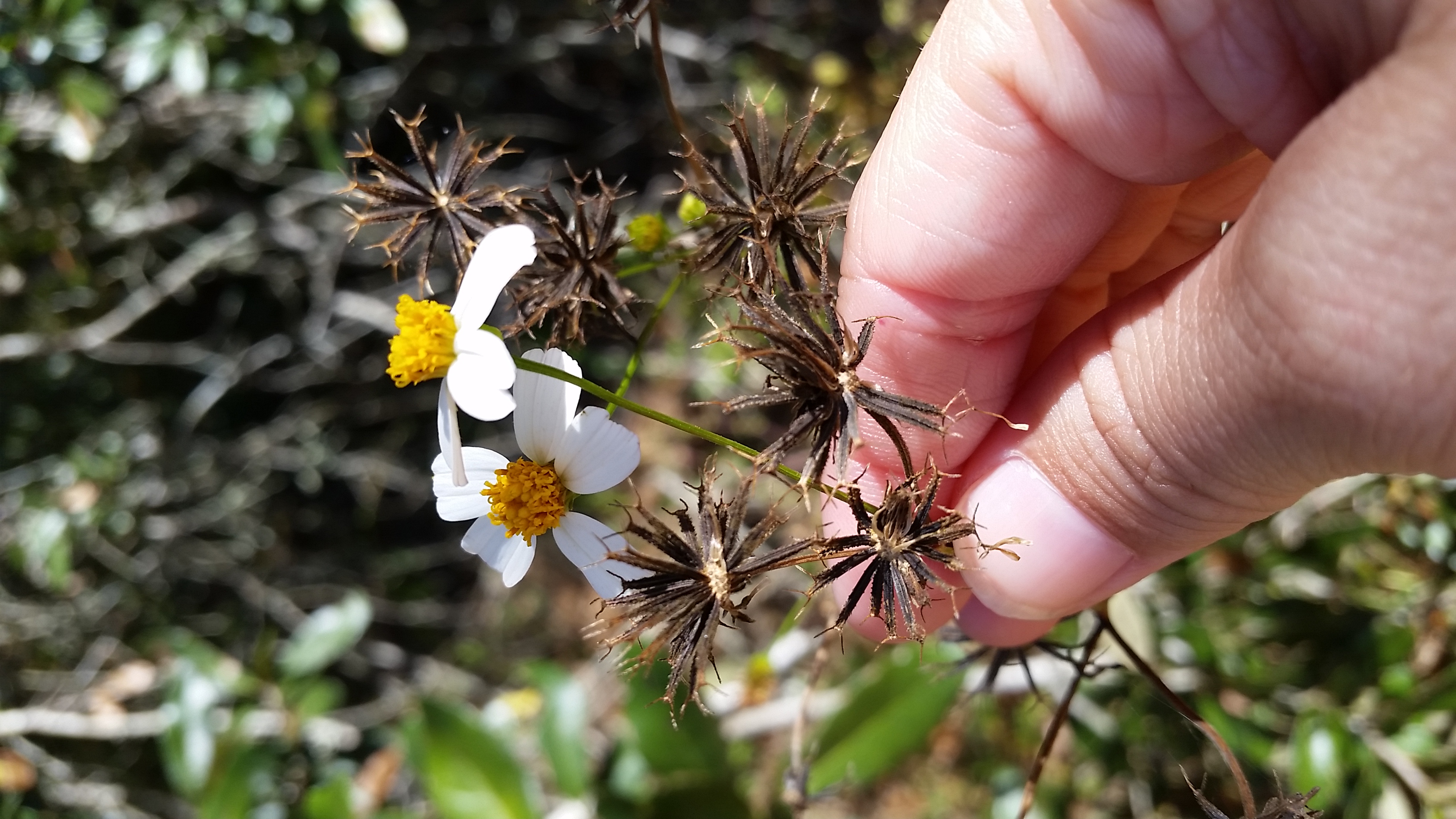Difference between revisions of "Bidens alba"
Krobertson (talk | contribs) (→Use by animals) |
|||
| Line 58: | Line 58: | ||
===Use by animals=== | ===Use by animals=== | ||
Beggar's-tick is a favorite nectaring flower of many species of butterflies.<ref>Hall D. W. 1991. The Joy of Weeds Common Beggar's-tick. Palmetto 11(1):15</ref> | Beggar's-tick is a favorite nectaring flower of many species of butterflies.<ref>Hall D. W. 1991. The Joy of Weeds Common Beggar's-tick. Palmetto 11(1):15</ref> | ||
| + | ''Bidens alba'' is pollinated by the bees ''Apis dorsata, A. florea'' (family Apidae), ''Hypanthidioides panamensis, Megachile albitarsis, M. mendica'' (family Magachilidae), and is host to the ladybugs ''Cycloneda sanguinea'' and ''Scymnus'' spp. (family Coccinellidae), leafhopper ''Acutalis tartarea'' (family Membracidae), and mealybugs ''Penacoccus citri'' and ''P. nipae'' (family Pseudoccoccidae.<ref>[ https://www.discoverlife.org/20/q?search=Bidens+albaDiscoverlife.org|Discoverlife.org]</ref> | ||
===Diseases and parasites=== | ===Diseases and parasites=== | ||
Revision as of 13:11, 8 June 2021
| Bidens alba | |
|---|---|

| |
| Photo taken by Michelle Smith | |
| Scientific classification | |
| Kingdom: | Plantae |
| Division: | Magnoliophyta - Flowering plants |
| Class: | Magnoliopsida - Dicotyledons |
| Order: | Asterales |
| Family: | Asteraceae ⁄ Compositae |
| Genus: | Bidens |
| Species: | B. alba |
| Binomial name | |
| Bidens alba (L.) DC. | |

| |
| Natural range of Bidens alba from USDA NRCS Plants Database. | |
Common names: Romerillo; Beggarticks
Contents
Taxonomic notes
Synonyms: Bidens pilosa Linnaeus; B. alba (Linnaeus) A.P. de Candolle var. radiata (Schultz ‘Bipontinus’) Ballard ex T.E. Melchert; B. pilosa Linnaeus var. radiata (Schultz ‘Bipontinus’).[1]
Varieties: Bidens alba (Linnaeus) A.P. de Candolle var. radiata (Schultz 'Bipontinus') Ballard ex T.E. Melchert.[1]
Description
B. alba is a weedy annual or a short lived perennial that has vertical roots.[2] [3] Leaves are arranged opposite with depressed midveins.[2]
Distribution
Ecology
Habitat
In the Coastal Plain in Florida, B. alba can be found in pine-oak woodlands.[4] It has been found to be common in disturbed areas such as railroads, citrus orchards, soil dumps and empty lots.[5][4] It has been observed to grow in loamy sand.[4] Associated species include Andropogon, Euphorbia, and Ambrosia.[4]
Phenology
Flowers January and May through November.[4] B. alba has been observed flowering in north Florida year round with peak inflorescence in February and May.[6]
Seed dispersal
The seed has two prongs that stick on to passing by animals, making dispersal zoochorous.[3]
Seed bank and germination
Under cooler conditions, newly added seeds in the seed bank have a slightly higher germination rates than seeds that have resided in the seed bank for a longer time.[5] Germination has also been observed at a wide range of temperatures, pH and salt concentrations; however, is inhibited at highly acidic and moderately alkaline soils and extreme water stress.[5] Germination is not sensitive to light.[5] Germination can be enhanced by splitting the end of the seed.[7]
Pollination
The following Hymenoptera families and species were observed visiting flowers of Bidens alba at Archbold Biological Station:[8]
Apidae: Apis mellifera, Bombus impatiens, B. pennsylvanicus, Mellisodes communis, M. comptoides, Nomada fervida
Halictidae: Agapostemon splendens, Augochlora pura, Augochlorella aurata, A. gratiosa, Augochloropsis metallica, Dieunomia heteropoda, Halictus poeyi, Lasioglossum pectoralis
Megachilidae: Anthidiellum notatum rufomaculatum, A. perplexum, Coelioxys dolichos, C. modesta, C. octodentata, C. sayi, Dolichostelis louisae, Heriades leavitti, Megachile albitarsis, M. brevis pseudobrevis, M. exilis parexilis, M. inimica, M. mendica, M. petulans, M. rugifrons, M. xylocopoides
Sphecidae: Ammophila pictipennis, A. urnaria, Bicyrtes capnoptera, Cerceris blakei, Isodontia exornata, Microbembex monodonta, Philanthus ventilabris
Vespidae: Eumenes smithii, Pachodynerus erynnis, Stenodynerus fundatiformis
Use by animals
Beggar's-tick is a favorite nectaring flower of many species of butterflies.[9] Bidens alba is pollinated by the bees Apis dorsata, A. florea (family Apidae), Hypanthidioides panamensis, Megachile albitarsis, M. mendica (family Magachilidae), and is host to the ladybugs Cycloneda sanguinea and Scymnus spp. (family Coccinellidae), leafhopper Acutalis tartarea (family Membracidae), and mealybugs Penacoccus citri and P. nipae (family Pseudoccoccidae.[10]
Diseases and parasites
Crypticerya genistae is an invasive scale insect native to Brazil and is found in association with B. alba.[11]
Morgan and Overholt (2005) found that the Brazilian pepper tree (Schinus terebinthifolius) had aqueous extracts that negatively affected the the growth of B. alba.[12]
Conservation, cultivation, and restoration
Cultural use
Photo Gallery
References and notes
- ↑ 1.0 1.1 Weakley, A.S. 2015. Flora of the southern and mid-atlantic states. Working Draft of 21 May 2015. University of North Carolina at Chapel Hill, Chapel Hill, North Carolina.
- ↑ 2.0 2.1 [Floridata] Accessed December 2, 2015
- ↑ 3.0 3.1 [Eat the Weeds] Accessed December 2, 2015
- ↑ 4.0 4.1 4.2 4.3 4.4 Florida State University Robert K. Godfrey Herbarium database. URL: http://herbarium.bio.fsu.edu. Last accessed: October 2015. Collectors: Loran C. Anderson, Ed Keppner, Lisa Keppner, R. Kral, Annie Schmidt, Kyle W. Shankle. States and Counties: Florida: Bay, Gulf, Indian River, Leon, Liberty, Martin, Wakulla. Compiled by Tall Timbers Research Station and Land Conservancy.
- ↑ 5.0 5.1 5.2 5.3 Ramirez, A. H. M., A. J. Jhala, et al. (2012). "Germination and Emergence Characteristics of Common Beggar's-Tick (Bidens alba)." Weed Science 60(3): 374-378.
- ↑ Nelson, G. PanFlora: Plant data for the eastern United States with emphasis on the Southeastern Coastal Plains, Florida, and the Florida Panhandle. www.gilnelson.com/PanFlora/ Accessed: 7 DEC 2016
- ↑ Hall D. W. 1991. The Joy of Weeds Common Beggar's-tick. Palmetto 11(1):15
- ↑ Deyrup, M.A. 2015. Database of observations of Hymenoptera visitations to flowers of plants on Archbold Biological Station, Florida, USA.
- ↑ Hall D. W. 1991. The Joy of Weeds Common Beggar's-tick. Palmetto 11(1):15
- ↑ [ https://www.discoverlife.org/20/q?search=Bidens+albaDiscoverlife.org%7CDiscoverlife.org]
- ↑ Hodges, G. S., Hodges, A. C., & Unruh, C. M.. (2008). A New Exotic Pest for Florida's Natural Areas: Crypticerya genistae (Hemiptera: Monophlebidae). The Florida Entomologist, 91(2), 335–337. Retrieved from http://www.jstor.org/stable/20065981
- ↑ Morgan, E. C., & Overholt, W. A.. (2005). Potential Allelopathic Effects of Brazilian Pepper (Schinus terebinthifolius Raddi, Anacardiaceae) Aqueous Extract on Germination and Growth of Selected Florida Native Plants. Journal of the Torrey Botanical Society, 132(1), 11–15. Retrieved from http://www.jstor.org/stable/20063740
